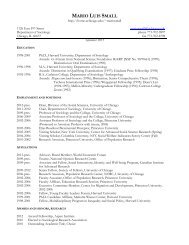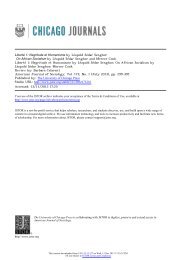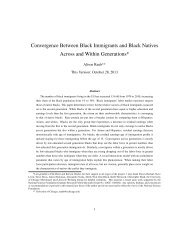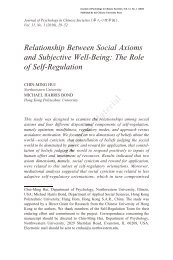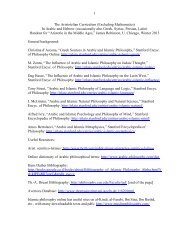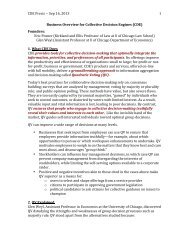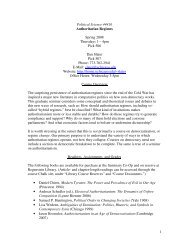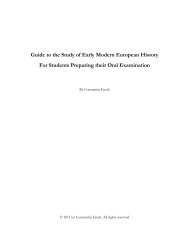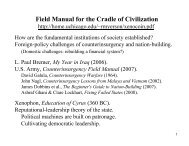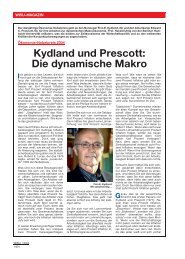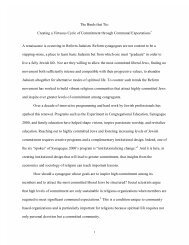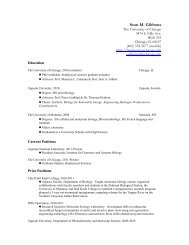Job Market Paper - Personal Web Pages - University of Chicago
Job Market Paper - Personal Web Pages - University of Chicago
Job Market Paper - Personal Web Pages - University of Chicago
Create successful ePaper yourself
Turn your PDF publications into a flip-book with our unique Google optimized e-Paper software.
Kim: Endogenous Choice <strong>of</strong> a Mediator<br />
A mediation mechanism µ is individually rational if and only if it satisfies the following participation<br />
constraints:<br />
U i (µ|t i ) ≥<br />
∑<br />
t −i ∈T −i<br />
p i (t −i |t i )u i (d 0 , t), ∀i ∈ N, ∀t i ∈ T i .<br />
Since the disagreement payments are normalized such that u i (d 0 , t) = 0 for all i and all t, the<br />
participation constraints reduce to<br />
U i (µ|t i ) ≥ 0, ∀i ∈ N, ∀t i ∈ T i .<br />
The revelation principle (Myerson, 1979) implies that a mechanism cannot be implemented<br />
by any equilibrium <strong>of</strong> a communication game induced by any communication system unless the<br />
mechanism is incentive compatible and individually rational. Thus, there is no loss <strong>of</strong> generality in<br />
focusing on such direct revelation mechanisms. 8<br />
Therefore, taking relevant incentive constraints into account, I define the incentive feasible mediator<br />
to be whoever mediates according to the incentive compatible, individually rational mediation<br />
mechanism for the above Bayesian bargaining problem. That is, by the revelation principle, I<br />
can naturally assume that players bargain over the set <strong>of</strong> incentive feasible mediators, denoted as<br />
F . As I take a mediator to be synonymous with a mechanism, I use the terms mediator and its<br />
corresponding mediation mechanism interchangeably throughout the paper.<br />
2.2 The Benchmark Model<br />
In this subsection, I consider the context <strong>of</strong> international relations in which two symmetric players,<br />
each with two discrete types, must make a decision d ∈ D. For example, two states are involved<br />
in a dispute over a divisible item, area <strong>of</strong> territory, or an allocation <strong>of</strong> resources that could lead to<br />
war.<br />
There are two possible decisions called d 0 and d 1 . Let D = {d 0 , d 1 }, where d 0 can be interpreted<br />
as going to war, and d 1 as peace (e.g., negotiated settlement). Each i = {1, 2} has private information<br />
t i ∈ T i = {s, w}, where s denotes the strong type and w denotes the weak type. I assume<br />
that the types are independent; that is, t i is drawn from the distribution ¯p i independent <strong>of</strong> t −i ,<br />
and this is common knowledge. For the sake <strong>of</strong> simplicity and tractability, I assume symmetry in<br />
probability – that the prior marginal probability <strong>of</strong> the strong types are the same for both players;<br />
8 See Holmström and Myerson (1983, 1804) and Myerson (1991, 487).<br />
8



